 |
 |
|
 |
Elected officials, transportation leaders explore mutual goals, priorities |
 |
 |
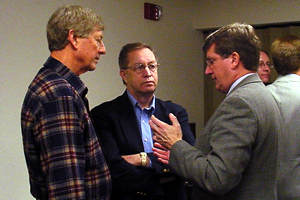 |
From left: State Rep. Dennis Frederickson, New Ulm, confers with Dave
Trooien, Willmar/District 8 engineer, and Kevin Gray, director, Corporate
Business Group, at the Granite Falls meeting. Photo by Sandy East
|
In a scenario that will be repeated several times statewide, Mn/DOT, county,
state and other transportation leaders met Nov. 26 in Granite Falls to examine
their mutual concerns to help set their transportation agendas for the next
session of the Minnesota Legislature.
Future briefings will be held in Brainerd, Duluth, Bemidji, Rochester and Mankato
during the week of Dec. 16.
The Southwest Chapter of the Minnesota Society of Professional Engineers sponsored
the Granite Falls meeting.
Co-hosts John Brunkhorst, McLeod County engineer, and Dave Trooien, Willmar/District
8 engineer, welcomed legislators and other elected officials, city and county
engineers, regional development commission directors as well as business and
community leaders from the region to the meeting.
Participants met informally to discuss transportation-related issues and heard
presentations from Mn/DOT’s Tim Worke, director of Government Relations, Trooien
and other District 8 staff. Briefing topics included funding issues, transit
services, regional traffic and population forecasts and Mn/DOT’s organizational
structure. The briefing also included a discussion of the Area Transportation
Partnership process.
Participants, Trooien said, agreed that legislators from Greater Minnesota
must make a joint effort to effectively support transportation improvements
to improve mobility and the state’s overall economic growth.
Many participants, he said, referred to highway improvement work on interregional
corridors such as Hwy 212 and Hwy 23 as examples of the benefits improved transportation
systems can bring to Greater Minnesota.
By Craig Wilkins
|
back

|
 |
Employees invited to meet Gov.-elect Tim Pawlenty Dec. 6 in C.O. |
 |
 |
Gov.-elect Tim Pawlenty will meet with Mn/DOT employees in the first floor
lobby of the Transportation Building at 11:30 a.m. on Friday, Dec. 6. Pawlenty
will outline the goals of his administration and the role he envisions for transportation
during the next four years.
Pawlenty will succeed Gov. Jesse Ventura on Jan. 6, 2003.
|
back

|
 |
Projected state budget deficit tops $4.5 billion |
 |
 |
The state of Minnesota faces a projected budget shortfall of $4.56 billion
for the next two years, about $1.5 million greater than the previous estimate.
The budget shortfall does not include about $1 billion in increases due to inflation.
There is also a $350 million shortfall for the final six months of the current
budget cycle.
The state’s budget for the next biennium was projected to be approximately
$31.6 billion; taking $4.5 billion from that total equates for 14 percent reduction.
The Department of Finance attributes the budget shortfall to the weak stock
market, a slow economic recovery and higher than projected human services expenditures.
Because the state’s Constitution forbids borrowing for operating purposes beyond
the end of a biennium, the FY 2003 deficit will need to be remedied before June
30, 2003.
For more information about the state’s projected budget, go to the St. Paul
Pioneer Press at http://www.twincities.com/mld/twincities/,
the Minneapolis Star Tribune at http://www.startribune.com
or other news media sources.
|
back

|
 |
Rebuilt Hwy 212 again links Olivia, Twin Cities |
 |
 |
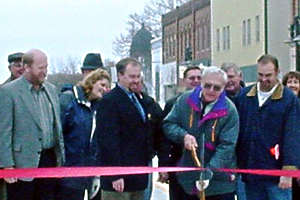 |
Cutting the ceremonial ribbon to reopen Hwy 212 are: Kelly Brunkhorst,
project engineer, Willmar/District 8 (second from left) along with (from
left) State Rep.-elect Lyle Koenen; Mark Matuska, representing U.S.
Rep. Mark Kennedy; Olivia Mayor Bill Miller, and Michael Funk, city
administrator. Photo by Sandy East
|
Improvements to a nine-mile section of Hwy 212 between Bird Island and Hector
brought a cross section of area residents to Olivia to celebrate the highway’s
reopening on Nov. 22.
Business and community leaders welcomed the highway’s reopening because of
its crucial role in the region’s economy.
The $14 million project involved concrete paving, bituminous shoulders and
adding a passing lane and lighting between Bird Island and Hector. In Olivia,
the highway was rebuilt and redesigned with a center left-turn lane and on-street
parking. The city replaced water and sewer facilities during reconstruction
and redesigned the downtown streetscape.
Civic leaders, elected officials and Mn/DOT staff joined the ribbon-cutting
ceremony in Olivia.
Dave Trooien, Willmar/District 8 engineer, said the project comprises part
of Mn/DOT’s efforts to rebuild Hwy 212, a primary interregional corridor that
links the area to the Twin Cities metropolitan area.
Trooien said the project was successful due to cooperation from communities
along the reconstruction project. He said, for example, a weekly newsletter
published by the Olivia Chamber of Commerce kept people affected by the project
informed, and the major contractor worked to keep access routes open to businesses
during construction.
Trooien said that the cooperative efforts demonstrated during the Hwy 212 project
will serve as a model for the district’s rebuilding of Hwy 23 in Spicer.
Kelly Brunkhorst, Willmar/District 8, served as project engineer.
By Sandy East
|
back

|
 |
‘Snowing money’ ties up freeway traffic as drivers dash for cash |
 |
 |
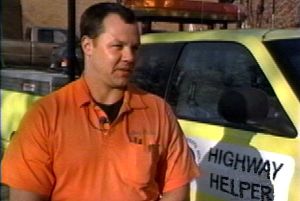 |
Highway Helper Jason Henry came to the rescue. Image from KMSP-9
TV.
|
It was the "first snowfall of the season" for the Twin Cities Metro
area, so to speak, but it wasn’t flakes falling from the skies. It was money
blowing around the I-94 freeway in the morning sunrise on Nov. 27, and, like
any snowfall, it backed up morning commuters for over a mile.
Motorists jumped out of their vehicles and scrambled to retrieve $50,000 in
small bills fluttering around the freeway, jamming I-94 traffic from Lexington
Avenue to St. Peter Street in St. Paul. The unexpected treasure came from a
moneybag that fell from an armored vehicle making a Federal Reserve Bank delivery
to a credit union in St. Paul.
‘It was snowing money’
The day’s treasure hunt began shortly after 7 a.m. when a Minnesota State Patrol
officer discovered a driver who parked his car on the Dale Street ramp to I-94.
The driver had stopped to pick up the money and had helped himself to a few
bills by the time the officer approached him.
"The first guy who stopped to pick up the money saw it as the sun came
up," said Highway Helper Jason Henry, the first Mn/DOT person on the scene.
"Then the trooper stops and sees the guy’s got $20 and $50 bills stuffed
in his pockets. Then the sun rises and it’s bright, and other motorists could
see the money blowing around."
The officer radioed the incident to his supervisor and then flagged Henry down.
"It was very chaotic," Henry said. "He asked me to ‘Get out
and help me get this money and get the traffic moving again.’ People were getting
out of their cars and blocking all of the lanes. It was snowing money. It was
literally hitting my windshield."
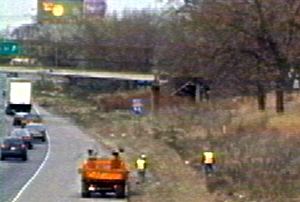 |
Metro crews help gather loose bills that fell from an armored car along
I-94 in St. Paul on Nov. 27. Image from KMSP-9 TV
|
Watching it live
Traffic Management Center staff watched it unfold live on the television screens
in the control room during their morning watch.
"What we saw at first was a vehicle parked on the ramp to Dale Street
with a patrol car parked behind it," said Teresa Hyde, TMC supervisor.
"Then we heard about it on the State Patrol radio. We continued to monitor
it, along with the other incidents in the metro area."
The TMC traffic cameras—which transmit live feeds that television stations
can monitor—displayed the proceedings live, including views of motorists picking
up the money. Some radio stations broadcast the event during morning traffic
reports, calling it a "public service announcement." After that, the
number of motorists stopping appeared to increase, according to Lt. Kent Matthews,
State Patrol.
"I actually saw a couple of people get out of their cars and start picking
up money," Hyde said. "We had people pulling over on the left shoulder
and the right shoulder, getting out of their vehicles, and doing very unsafe
things."
‘They were just full of leaves and money’
Metro Division Maintenance workers from the Maryland Ave. Truck Station joined
Highway Helpers and officers who raced to the scene to recover what they could
before the motorists, winds and storm drains carried it away.
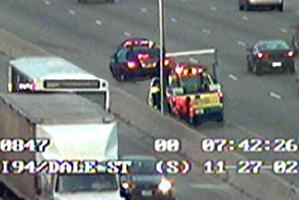 |
Highway Helper Jason Henry followed the money down eight storm drains
in the middle of I-94 while morning commuters rushed by. Image from
TMC traffic camera
|
"We went up and down the shoulders and picked up money and tried to shoo
the treasure-hunters away," Henry said. "We’d head west to Lexington
Avenue, picking up more money. It was blowing into the eastbound lanes, so we’d
turn around and work our way back east."
In order to retrieve about $1,100 that had actually gone down the drain, Henry
followed the money—right down the drains.
"We’d pop the grate out and I’d shimmy down and grab a couple fistfuls
of bills," he said. "Then I’d hand them up to the trooper and shimmy
up the hole. Then we’d go on to the next drain...eight of them in all, all in
a row. They were just full of leaves and money."
By 9:00 a.m., traffic cleared up and the news media arrived. By this time,
officers and Mn/DOT workers had managed to retrieve about 90 percent of the
cash.
"It was a once-in-a-lifetime thing," Henry said. "It seemed
like it was straight out of Hollywood."
By Marsha Storck
|
back

|
 |
36-year-old section of I-35 earns pavement durability award |
 |
 |
 |
A heavy truck rolls northward along I-35 near Willow River on a section
of I-35 cited for excellence in durability by the Asphalt Pavement Alliance.
Photo by John Bray
|
The durability built into a section of I-35 earned a pavement design award
for Duluth/District 1 engineering staff from the national Asphalt Pavement Alliance.
The award honors a seven-mile section of the freeway built in 1966 between
Willow River and the Carlton/Pine county line.
The design earned the alliance’s Perpetual Pavement Award for durability, excellence
in design, quality of design and value to the traveling public. The freeway
section was built during the time Mn/DOT was changing its road-building techniques,
moving from using asphalt surface treatments to deep-strength asphalt pavement.
The alliance also honored four other sections of the interstate system and
runways at two airports in the United States.
When constructed in 1966, the roadway included a 12-inch sub-base of granulated
material, four inches of bituminous gravel base and four inches of plant-mixed
bituminous base. The top layer was four inches of hot mix asphalt designed for
high-traffic areas.
The roadway did not require an overlay until 1989. Ten years later it was milled
again and received a 4.5-inch asphalt overlay.
Average daily traffic on the freeway section is 14,400.
"This seven-mile stretch of I-35 is part of one of the key corridors in
Minnesota," said Doug Weiszhaar, acting commissioner. In addition to carrying
nearly 15,000 vehicles every day, the roadway endures temperature extremes from
30 degrees below zero in winter to 90 degrees and hotter during the summer.
"About 75 percent of Minnesota’s highway system was originally built more
than 30 years ago; as our highways get older, maintenance and repair costs are
increasing. Durable highways like this section of I-35 save taxpayers money
in maintenance costs and allow us to stretch our scarce resources further,"
he said.
By Craig Wilkins
|
back

|
 |
Last towboat heads south |
 |
 |
 |
The last towboat and its load of barges heads south on the Mississippi
River from St. Paul. Photo by Dick Lambert
|
Another sign of winter hit the state Nov. 26 when the last towboat in Minnesota
left the Twin Cities and headed south along the Mississippi River, departing
ahead of some of the birds that migrate south each year. The departure of the
last towboat caught the media’s attention even though the previous year was
the shortest shipping season on record, according to Dick Lambert, director,
Ports and Waterways.
Lambert said the 2002 Minnesota shipping season lasted 252 days, which is close
to state’s average of 257 days.
He explained that sudden freezing could trap any barges still in the area.
By the time the last towboat left last week, the Mississippi River’s temperature
had dropped to the mid-30s.
To read about this and other news items released to the media recently, visit
the News and Views page on
the Mn/DOT Web site. Some of the most recent news releases include:
North
zone winter load increases in effect Dec. 6
Caution
urged at new rail line crossings
|
back

|
 |
Central Office celebrates Native American Heritage Month |
 |
 |
Mn/DOT employees celebrated Native American Heritage Month in November with
Native Americans from the White Earth Reservation. About 130 employees feasted
on Native American cuisine while watching the White Earth Youth Drum and Dance
group perform. Afterwards, employees learned a traditional Native American dance.
"Employees who attended said the performance changed their perception
of Native Americans in a positive way," said Liz Pawlak, Performance Planning
and Measurement.
The group brought several types of Native American foods including wild rice,
fried bread, blueberry crisp and tea made from native plants.
An historian spoke about their history as a people, including information about
land treaties, the languages they speak and the importance of the drum in their
culture.
The diversity committees from Program Support Group, Modal Operations and the
Management Operations Group sponsored the event.
By Shayla Cain
|
back

|
 |
|
 |



